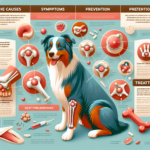Portuguese Podengo Joint Pain: Causes, Symptoms, Prevention, and Treatment

Introduction
The Portuguese Podengo is a versatile and ancient breed originating from Portugal. Known for its keen hunting abilities, the Podengo comes in three sizes: small (Pequeno), medium (Médio), and large (Grande). Each size has its unique characteristics, but all share a common history of being agile, energetic, and intelligent dogs. Historically, they were used for hunting rabbits and other small game, a task they performed with remarkable skill and enthusiasm.
Despite their robust nature, Portuguese Podengos are not immune to health issues. Like many breeds, they can be prone to certain genetic and age-related conditions. One of the most significant concerns for Podengo owners is joint pain, which can severely impact the dog’s quality of life if not properly managed.
Joint health is particularly crucial for the Portuguese Podengo due to their active lifestyle and hunting background. Healthy joints are essential for maintaining their agility and overall well-being. Understanding the causes, symptoms, prevention, and treatment of joint pain in this breed is vital for ensuring they lead a happy and active life.
Breed-Specific Joint Pain Risks
Genetic Predisposition
Portuguese Podengos, like many purebred dogs, can be genetically predisposed to joint-related issues. Common conditions include hip dysplasia, elbow dysplasia, and arthritis. Hip dysplasia is a malformation of the hip joint that can lead to arthritis and pain. Elbow dysplasia involves abnormal development of the elbow joint, causing lameness and discomfort. Arthritis, a degenerative joint disease, can affect any joint and is often seen in older dogs.
Age-Related Risks
As Portuguese Podengos age, the risk of developing joint pain increases. While younger dogs may show few signs of joint issues, older Podengos are more susceptible to arthritis and other degenerative joint conditions. Owners should be vigilant as their dogs approach middle age, typically around 5-7 years, and continue to monitor their joint health as they grow older.
Activity Level and Joint Stress
The Portuguese Podengo’s high energy levels and active lifestyle can contribute to joint stress. These dogs are natural hunters and require regular exercise to stay healthy. However, excessive or inappropriate exercise can strain their joints, leading to pain and discomfort. Activities like jumping, running on hard surfaces, or sudden changes in direction can exacerbate joint issues.
Common Symptoms of Joint Pain in Portuguese Podengo
General Symptoms
Owners should be aware of the general symptoms of joint pain, which include:
- Limping or favoring one leg
- Stiffness, especially after rest
- Reluctance to move, jump, or climb stairs
- Decreased activity or playfulness
- Swelling around the joints
- Whining or showing signs of discomfort when touched
Breed-Specific Symptoms
In Portuguese Podengos, joint pain may manifest in specific ways due to their unique build and activity levels. Owners might notice a decrease in their dog’s agility or reluctance to engage in hunting or chasing games. Additionally, Podengos may show a preference for softer surfaces to lie on, avoiding hard floors that can exacerbate joint pain.
When to Consult a Vet
If any of the above symptoms are observed, it is crucial to consult a veterinarian. Early diagnosis and treatment can significantly improve the dog’s quality of life. Persistent limping, noticeable pain, or any sudden changes in behavior should prompt an immediate veterinary visit.
Preventive Measures for Joint Health
Exercise Recommendations
Regular, moderate exercise is essential for maintaining joint health in Portuguese Podengos. Activities like walking, swimming, and controlled play are beneficial. Avoid high-impact exercises such as jumping or running on hard surfaces. Tailor the exercise routine to the dog’s age and physical condition, gradually increasing intensity as appropriate.
Dietary Suggestions
A balanced diet rich in essential nutrients supports joint health. Consider incorporating foods or supplements that contain glucosamine, chondroitin, and omega-3 fatty acids. These nutrients help maintain cartilage health and reduce inflammation. Consult with a veterinarian to determine the best dietary plan for your Podengo.
Weight Management
Maintaining a healthy weight is crucial for reducing joint stress. Overweight dogs are more prone to joint issues due to the extra load on their joints. Monitor your Podengo’s weight and adjust their diet and exercise routine as needed to keep them at an optimal weight.
Early Screening and Monitoring
Regular veterinary check-ups are essential for early detection of joint issues. Screening tests such as X-rays can help identify problems before they become severe. Early intervention can prevent further deterioration and improve the dog’s quality of life.
Treatment Options for Joint Pain
Non-Surgical Treatments
Non-surgical treatments for joint pain include:
- Medications: Anti-inflammatory drugs and pain relievers can help manage pain and reduce inflammation.
- Physical Therapy: Exercises and therapies designed to strengthen muscles and improve joint function.
- Lifestyle Adjustments: Modifying the dog’s activity level and environment to reduce joint stress.
Surgical Options
In severe cases, surgical intervention may be necessary. Common surgeries for joint pain include:
- Hip Replacement: Replacing the damaged hip joint with an artificial one.
- Arthroscopy: A minimally invasive procedure to clean out the joint and remove damaged tissue.
- Joint Fusion: Fusing the joint to eliminate pain from movement.
Alternative Therapies
Alternative treatments can also be beneficial for managing joint pain. These include:
- Acupuncture: Using needles to stimulate specific points on the body to relieve pain.
- Hydrotherapy: Water-based exercises that reduce joint stress while improving strength and mobility.
- Massage: Therapeutic massage to relieve muscle tension and improve circulation.
Lifestyle and Management Tips
Daily Care Routine
A daily care routine for a Portuguese Podengo with joint pain might include:
- Gentle morning walks to loosen stiff joints
- Administering prescribed medications or supplements
- Engaging in low-impact play or swimming sessions
- Providing a comfortable resting area with orthopedic bedding
- Regularly monitoring the dog’s weight and adjusting their diet as needed
Modifying the Home Environment
Making the home more comfortable for a dog with joint pain can significantly improve their quality of life. Consider the following modifications:
- Installing ramps to help the dog access furniture or climb stairs
- Providing orthopedic beds to support their joints while resting
- Using non-slip mats to prevent falls on slippery surfaces
- Ensuring food and water bowls are at a comfortable height
Long-Term Management
Long-term management of joint pain involves a combination of regular veterinary care, appropriate exercise, a balanced diet, and a supportive home environment. Consistent monitoring and adjustments to the dog’s routine can help manage pain and maintain their quality of life.
FAQs About Portuguese Podengo and Joint Pain
What are the early signs of joint pain in Portuguese Podengos?
Early signs include limping, stiffness, reluctance to move, and decreased activity levels. If you notice any of these symptoms, consult your veterinarian for a thorough examination.
Can joint pain in Portuguese Podengos be prevented?
While genetic predispositions cannot be entirely prevented, maintaining a healthy weight, providing appropriate exercise, and regular veterinary check-ups can help reduce the risk and severity of joint pain.
Are there specific exercises that are better for Portuguese Podengos with joint pain?
Low-impact exercises such as walking, swimming, and controlled play are beneficial. Avoid high-impact activities like jumping or running on hard surfaces.
What dietary supplements are recommended for joint health in Portuguese Podengos?
Supplements containing glucosamine, chondroitin, and omega-3 fatty acids are commonly recommended to support joint health. Always consult your veterinarian before adding supplements to your dog’s diet.
When should I consider surgery for my Portuguese Podengo’s joint pain?
Surgery is typically considered when non-surgical treatments are no longer effective, and the dog’s quality of life is significantly impacted. Your veterinarian can help determine the best course of action based on your dog’s specific condition.
Conclusion
Joint pain is a significant concern for Portuguese Podengo owners, but with proper understanding and management, it is possible to maintain your dog’s quality of life. By recognizing the symptoms early, taking preventive measures, and exploring various treatment options, you can help your Podengo stay active and happy. Regular veterinary consultations and a proactive approach to joint health are essential for ensuring your dog’s well-being.
Remember, each dog is unique, and what works for one may not work for another. Always consult with your veterinarian to develop a tailored plan that meets your Portuguese Podengo’s specific needs.




